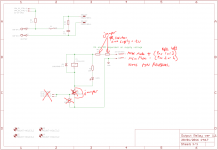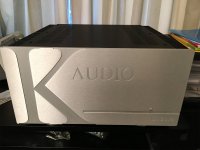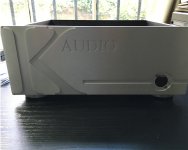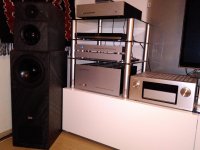The action of the output relay control is changed a little and requires a modest change on the output relay board from before. In Toni's earlier circuit the MCU controlled a transistor on the output relay board on the low side of the relay to allow current to flow through it while the output relay was supplied 12V from some other PSU (the mains supply to which was controlled by one of the relays on the in-rush board). With this version, 12V (and -12V) is supplied to the MCU and the MCU controls the onward supply to the output relay. So the output board can be simplified a little.
See attached
Attachments
Last edited:
Would not do this. First power is attached to amplifier and preamplifier and with a configurable delay the output speaker relay will activate. The amplifier needs some time to settle up. DC offset ...See attached
BR, Toni
The MCU only supplies power to the output relay (where I wrote MCU Mute +-) after this configurable delay that you have built into the software. (Pic pin 16 goes high after the delay and only then is power fed to output relay board.) Effectively Q1 in the schematic in #1881 has been shifted to the SMD MCU.
Last edited:
The MCU only supplies power to the output relay ...
Sorry - now I see the difference - you meant your extra speaker relay board - this of course can be modified as you have shown.
BR, Toni
Astx, this amp seems to be a monster. It can probably drive any load.
But in anormal living room you normally don't use many of the available Watts - typically one or two with some peaks. I have been building minimalistic amps for a while and thought it would be nice to compare them to something more like.. well a super "blameless" amp with many transistors etc..
But what is your subjective impression of the sound that comes out of it? Douglas Self coined the phrase "blameless" amp - implying that such an amp was indistinguishable from any other well designed amp.
So perhaps you haven't really made any listening tests - it would indeed be useless if the amp really is "blameless".
So this may be something good about building monster amps. You can just relax in front of your stereo, well aware that you can't get something better. Quite appealing, you don't have to worry any more.
Regards.
But in anormal living room you normally don't use many of the available Watts - typically one or two with some peaks. I have been building minimalistic amps for a while and thought it would be nice to compare them to something more like.. well a super "blameless" amp with many transistors etc..
But what is your subjective impression of the sound that comes out of it? Douglas Self coined the phrase "blameless" amp - implying that such an amp was indistinguishable from any other well designed amp.
So perhaps you haven't really made any listening tests - it would indeed be useless if the amp really is "blameless".
So this may be something good about building monster amps. You can just relax in front of your stereo, well aware that you can't get something better. Quite appealing, you don't have to worry any more.
Regards.
It's a 3pair output stage and the lateral mosFETs come in 100W to 125W versions.
Thus the maximum output is ~ 3*2*100 / 4 = ~150W using the 100W devices, upto ~200W if using the 125W devices.
That's not monster capability.
If one were to use double die versions in the 250W variety, then you can get to 3*2*250 / 4 = ~370W, that's geting close to monster capability.
One could use just the two outer locations for the output devices and there install the 250W double die versions for a maximum output of ~ 250W
Thus the maximum output is ~ 3*2*100 / 4 = ~150W using the 100W devices, upto ~200W if using the 125W devices.
That's not monster capability.
If one were to use double die versions in the 250W variety, then you can get to 3*2*250 / 4 = ~370W, that's geting close to monster capability.
One could use just the two outer locations for the output devices and there install the 250W double die versions for a maximum output of ~ 250W
Last edited:
Yes. that's right, it wasn't that monstrous after all when I looked closer to the diagram.
But I'm thinking of two things.
1. If I would build this one, it would be nice to get some review from a subjective point of view. ( With the usual bloomy hifi reviewer vocabulary )
2. Why use three output stages in parallel? Isn't one enough?
When it comes to BJT we have the beta droop at around 5 amps or so and paralleling them makes some sense. But mosfet? The gm wont be any better when used in parallel. Any mosfet has roughly the same gm at a specific current - at least ordinary power mosfet's. The difference will be Rds on, but that's not of so much importance. Firstly it will be bootstrapped by the load resistance, then the NFB will take care of the rest. Power? In a normal hifi session the power usually is quite low, even in large listening rooms. The exception is of course PA systems.
Drawbacks: well parallel devices usually are hard to match to 100% so additional harmonics may be added.
I see one very good situation where parallellism may be useful. Let's say you have a class A amp that dissipates 300W at idle, then it's hard to find thermal insulators that has low enough of thermal resistance. ( alu oxide is more expensive than the transistor) Using many in parallel spreads the heat burden over several devices.
Any comments?
But I'm thinking of two things.
1. If I would build this one, it would be nice to get some review from a subjective point of view. ( With the usual bloomy hifi reviewer vocabulary )
2. Why use three output stages in parallel? Isn't one enough?
When it comes to BJT we have the beta droop at around 5 amps or so and paralleling them makes some sense. But mosfet? The gm wont be any better when used in parallel. Any mosfet has roughly the same gm at a specific current - at least ordinary power mosfet's. The difference will be Rds on, but that's not of so much importance. Firstly it will be bootstrapped by the load resistance, then the NFB will take care of the rest. Power? In a normal hifi session the power usually is quite low, even in large listening rooms. The exception is of course PA systems.
Drawbacks: well parallel devices usually are hard to match to 100% so additional harmonics may be added.
I see one very good situation where parallellism may be useful. Let's say you have a class A amp that dissipates 300W at idle, then it's hard to find thermal insulators that has low enough of thermal resistance. ( alu oxide is more expensive than the transistor) Using many in parallel spreads the heat burden over several devices.
Any comments?
There are several amps now discussed in this thread. The first, and the one I have built, has been rated by Toni at 200W into 8R or 400W into 4R.
Me, if I am going to build something for my main speakers I want something with plenty of reserve. Speaker efficiency? Distance to listening position/size of room? Heavy transients in material recorded with very good dynamic range? I consider the c750W per channel likes of the SAE 2HP (peak or RMS - not sure for that one) "monster capability", but not 200W rms.
I hate giving subjective opinions on audio gear. The cr*p one reads in reviews is baffling to me. Bigger soundstage? Greater separation? Blah blah. Maybe my hearing is really bad, I've only had good gear or I need to do a course in the dark art of audio gear review to better express what I hear, but I can say that Toni's SA2014 is an incredibly enjoyable amp. It betters my Krell FPB 200. The best I can say is that it performs effortlessly and with a greater sense of "cleanliness" than the Krell.
At the moment my gear is in what I consider to be a very small room - but that's just because I live in London. It is circa 4.9m x 4.1m and its dimensions and construction (Victorian brick 'n mortar etc) are hardly ideal. (A couple of RPG Modex plates help but ideally I would have another pair. I've tossed in some Bad panels as well but the Modex plates are the bee's knees for bass absorption.) So it takes a lot less power than would a very large room. But I am also running Dirac Live which has a considerable amount of attenuation.
I've given this amp a really good thrashing now with a lot of "very neighbour-impolite volume levels and transient packed content". I like it a lot. Even at this time of year I don't miss my Krell heater.
(My speakers are Egglestonworks Andra III. DACs are Theta Digital Xtreme D3 in a Casablanca IV.)
Me, if I am going to build something for my main speakers I want something with plenty of reserve. Speaker efficiency? Distance to listening position/size of room? Heavy transients in material recorded with very good dynamic range? I consider the c750W per channel likes of the SAE 2HP (peak or RMS - not sure for that one) "monster capability", but not 200W rms.
I hate giving subjective opinions on audio gear. The cr*p one reads in reviews is baffling to me. Bigger soundstage? Greater separation? Blah blah. Maybe my hearing is really bad, I've only had good gear or I need to do a course in the dark art of audio gear review to better express what I hear, but I can say that Toni's SA2014 is an incredibly enjoyable amp. It betters my Krell FPB 200. The best I can say is that it performs effortlessly and with a greater sense of "cleanliness" than the Krell.
At the moment my gear is in what I consider to be a very small room - but that's just because I live in London. It is circa 4.9m x 4.1m and its dimensions and construction (Victorian brick 'n mortar etc) are hardly ideal. (A couple of RPG Modex plates help but ideally I would have another pair. I've tossed in some Bad panels as well but the Modex plates are the bee's knees for bass absorption.) So it takes a lot less power than would a very large room. But I am also running Dirac Live which has a considerable amount of attenuation.
I've given this amp a really good thrashing now with a lot of "very neighbour-impolite volume levels and transient packed content". I like it a lot. Even at this time of year I don't miss my Krell heater.
(My speakers are Egglestonworks Andra III. DACs are Theta Digital Xtreme D3 in a Casablanca IV.)
Yes. that's right, it wasn't that monstrous after all when I looked closer to the diagram.
But I'm thinking of two things.
1. If I would build this one, it would be nice to get some review from a subjective point of view. ( With the usual bloomy hifi reviewer vocabulary )
2. Why use three output stages in parallel? Isn't one enough?
...
Why not open a thread to discuss the philosophical part separate?
Ad 1) All in this thread presented designs are working, are carefully tested using professional measurement equipment and have been verified in many listening tests.🙂
The good thing: you can build it if you want but you must not build it if you don't want to!😉
Ad 2) Paralleling output devices can reduce noise and distortion (wider class A range; using the linear range of beta thus avoiding too early beta droop; narrower thermal range from small signal listening to full power peeks also reduces distortions). Of course the disadvantage is that it is harder to drive more ops devices because of higher total gate/base capacitance. Maybe harder to get them thermally stable. Also you need of course some matching too ...
If you don't like the idea that your amplifier is able to deliver continuous 20kHz@200W@8R or 20kHz@400W@4R or similar with distortion figures below 0.005% you may stop reading this thread...😀
BR, Toni
Last edited:
Really nice enclosure!
It is a must for this excellent amplifier!🙂
Perhaps i will have something like this in the future.
I wish to have the opportunity for a complete diy amplifier.
It is a must for this excellent amplifier!🙂
Perhaps i will have something like this in the future.
I wish to have the opportunity for a complete diy amplifier.

Thanks! All my builds have the same styling - I am stuck with it!
First pic: audio server with discrete linear supply
Second pic: enclosure for "The Wire Bal:Bal" headphone amp
All done by Modu - a trial at times but ultimately good
First pic: audio server with discrete linear supply
Second pic: enclosure for "The Wire Bal:Bal" headphone amp
All done by Modu - a trial at times but ultimately good
Attachments
SGK, congratulations to your very nice built SA amp. You have chosen an excellent design! Toni´s documents and boards make such substantial projects be a very joyful experience.
I am very lucky - now and then I can hear the original at Toni´s place. Simply a stunning amp.
I am very lucky - now and then I can hear the original at Toni´s place. Simply a stunning amp.
Absolutely amazing builds! 🙂
BTW: Your speakers are really very good ones!
Here a quick overview of my listening equipment from top to bottom and left to right:
BTW: Your speakers are really very good ones!
Here a quick overview of my listening equipment from top to bottom and left to right:
- DIY Speaker "M50 TL BE" based on ScanSpeak and ATC chassis in a very heavy stone case (build using brazilian slate) - 150kg per speaker
- DIY Audio/Video server running Linux (case made by my friend using my own CNC machine)
- Panasonic Blu-Ray player BDT500 (with audiophile Burrbrown DAC's; I'm using it as DAC reference and of course viewing HD-Video)
- DIY Analog active crossover Linkwitz Riley 24dB (crossover point at 380Hz)
- DIY power conditioner to block DC on AC mains
- DIY SA2014 - 4 Channel amplifier (46kg)
- AVR-X7200W - Denon
Attachments
Absolutely amazing builds! 🙂
BTW: Your speakers are really very good ones!
Here a quick overview of my listening equipment from top to bottom and left to right:
- DIY Speaker "M50 TL BE" based on ScanSpeak and ATC chassis in a very heavy stone case (build using brazilian slate) - 150kg per speaker
- DIY Audio/Video server running Linux (case made by my friend using my own CNC machine)
- Panasonic Blu-Ray player BDT500 (with audiophile Burrbrown DAC's; I'm using it as DAC reference and of course viewing HD-Video)
- DIY Analog active crossover Linkwitz Riley 24dB (crossover point at 380Hz)
- DIY power conditioner to block DC on AC mains
- DIY SA2014 - 4 Channel amplifier (46kg)
- AVR-X7200W - Denon
😱😱😱
like a dream!
Yes, everyone seems to be very happy with it. Actually I love the philosophical part, which is also related to psycho acoustics, but whenever I start talking about that nobody seems to be particularly interested, but I would love to start such a thread since I think that placebo/THD/subjectivist/rationalist thing is so complex and needs to be discussed. Well "needs" - really we just need to be happy and listen to music etc..
SGK, congratulations to your very nice built SA amp. You have chosen an excellent design! Toni´s documents and boards make such substantial projects be a very joyful experience.
I am very lucky - now and then I can hear the original at Toni´s place. Simply a stunning amp.
BTW: "Tiroler" has just added a new thread - building of SA2012 - 4 channel amplifier. His metal work and design skills are extraterrestrial - have a look here and enjoy:
http://www.diyaudio.com/forums/chip-amps/301878-sa-2012-amplifier-lme49830.html
BR, Toni
...
Actually I love the philosophical part, which is also related to psycho acoustics, ...
It's worth a new thread to discuss psycho acoustics et al.
You could post the link here ...
I personally recommend the book from Floyd E. Toole "Sound Reproduction".
BR, Toni
Wow! 150kgs per speaker? Nice system.
You guys are also lucky to live in such a beautiful part of the world!
You guys are also lucky to live in such a beautiful part of the world!
Wow! 150kgs per speaker? Nice system.
You guys are also lucky to live in such a beautiful part of the world!
The good news: your wife will not be able to move the speakers ...
The bad news: if you want to move the speakers to another location (even if it is only a few centimeters) you will need minimum 6 helping hands ...
About Tyrol as a beautiful part: take a break on amplifier building and ...
BR, Toni
- Home
- Amplifiers
- Solid State
- 2stageEF high performance class AB power amp / 200W8R / 400W4R




